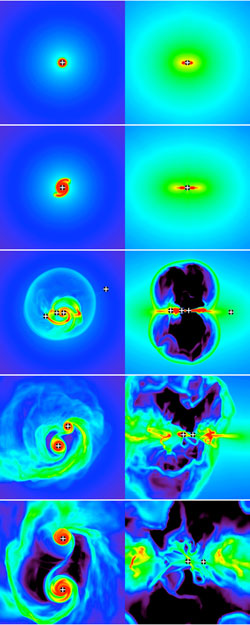How Massive Stars Form: Simple Solution Found

Theexistence of massive stars ? up to a whopping 120 times the mass of the sun ? haslong perplexed astronomers. The big question was how these stellar behemothsreached their enormous sizes without blowing off all the gas that feeds them.
A newcomputer simulation of starformation has found a surprisingly simple solution to how these stars mightget around this problem.
The newfindings, detailed in the Jan. 16 issue of the journal Science, alsoexplain why thesegiants tend to occur in binary or multiple star systems.
"Wedidn?t' set out to solve that question, so it was a nice side benefit of thestudy," said study leader Mark Krumholz of the University of California, Santa Cruz.
Balancingforces
When a starbegins to form, two opposing forces are at play. One is the pull of gravitycreating by the rotating gas cloud from which the star is born. Gravity pullsthe gaseous material in, feeding the protostar.
The otherforce, called radiation pressure, is generated by the growing star itself. Thispressure is the force exerted by electromagnetic radiation on the surfaces itstrikes. For ordinary light, this force is nearly negligible, but it becomessignificant in the interior of stars because of the intensity of theirradiation.
Get the Space.com Newsletter
Breaking space news, the latest updates on rocket launches, skywatching events and more!
For massivestars, radiation pressure is the dominant outward-flowing force counteractinggravity's inward pull to prevent the further collapse of the star. Previousstudies had suggested that radiation pressure would blow away a star's gascloud before the star could grow much larger than 20 times the mass of the sun.
"Whenyou apply the radiation pressure from a massive star to the dusty interstellargas around it, which is much more opaque than the star's internal gas, itshould explode the gas cloud," Krumholz explained.
Yet plentyof these massive stars have been spotted by astronomers (though they are rarerthan small stars).
Surprisesolution
Krumholzand his colleagues solved the dilemma with a three-dimensional computersimulation of the collapse of a giant interstellar gas cloud to form a massivestar. Their research was funded by the National Science Foundation, NASA andthe U.S. Department of Energy.
As thedusty gas collapsed, onto the star's growing core, instabilities developed thatresulted in channels where radiation blew out through the cloud intointerstellar space, while gas continued falling inward through other channels.
"Youcan see fingers of gas falling in and radiation leaking out between thosefingers of gas," Krumholz said. "This shows that you don't need anyexotic mechanisms; massive stars can form through accretion processes just likelow-mass stars."
The disk ofthe collapsing gas also did something unexpected: it clumped to form a seriesof small secondary stars, mostof which collided into the primary star, but some of which came to be starsin their own right and formed a multiple star system.
"Ithink now we can consider the mystery of how massive stars are able to form tobe solved," Krumholz said.
- Video ? When Stars Collide
- Super Stars Require Right Environment to Rise
- Top 10 Star Mysteries
Join our Space Forums to keep talking space on the latest missions, night sky and more! And if you have a news tip, correction or comment, let us know at: community@space.com.

Andrea Thompson is an associate editor at Scientific American, where she covers sustainability, energy and the environment. Prior to that, she was a senior writer covering climate science at Climate Central and a reporter and editor at Live Science, where she primarily covered Earth science and the environment. She holds a graduate degree in science health and environmental reporting from New York University, as well as a bachelor of science and and masters of science in atmospheric chemistry from the Georgia Institute of Technology.









